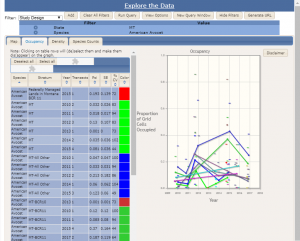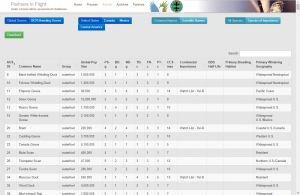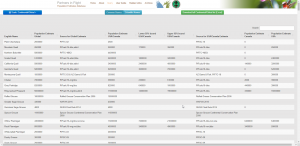
The following are some examples of the tools and resources in the AKN that bird conservation organizations might use to answer some commonly asked questions:
I am looking to target management or conservation efforts for a particular bird species based on species occurrence at sampled locations in the western U.S.
[showhide type=”post1″ more_text=”See what tools and resources might help you do this…” less_text=”Collapse…”]
RMADC Data Exploration and Analysis Interface – The Rocky Mountain Avian Data Center (RMADC) hosts Integrated Monitoring in Bird Conservation Regions (IMBCR) and other data collected by collaborators in the Rocky Mountains, Great Plains, and Intermountain West. It is intended to provide population estimates (both density and occupancy), approximate survey locations, and species counts to wildlife biologists, land managers, and other conservation practitioners who may use these data to inform management and conservation decisions. Population estimates are provided at a variety of scales and account for incomplete detectability of birds. The RMADC is hosted by Bird Conservancy of the Rockies and has been made possible through a broad partnership of state, federal, and non-governmental agencies.
[/showhide]
I would like to get baseline population estimates and information regarding where species occur in a region of interest.
[showhide type=”post2″ more_text=”See what tools and resources might help you do this…” less_text=”Collapse…”]
Partner’s in Flight Conservation Assessment Database – This database provides global and regional conservation assessments of each bird species that, among other uses, can be used to objectively assign regional and continental conservation priorities among birds. Currently, Bird Conservancy of the Rockies maintains PIF species assessment data on all bird species in the U.S. Canada, and Mexico.
Partner’s in Flight Landbird Population Estimates Database – This database aims to: (1) provide users access to the estimates of landbird populations published in the North American Landbird Conservation Plan (Rich et al. 2004), which were based mainly on Breeding Bird Survey data from the 1990s: (2) allow users to view and download estimates for landbird populations at a variety of geographic scales, and (3) provide transparent access to the methodologies, assumptions, data sources, and species-specific correction factors used by Partners in Flight to create these estimates.
[/showhide]



